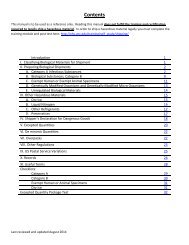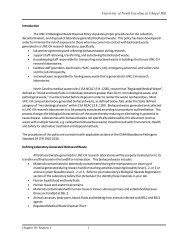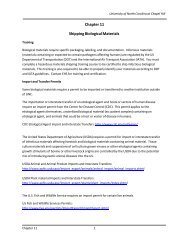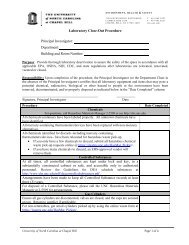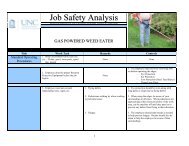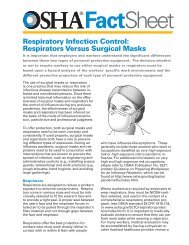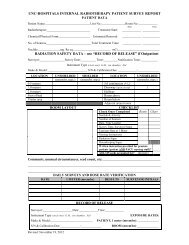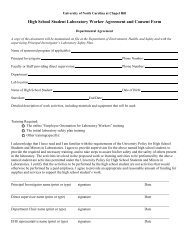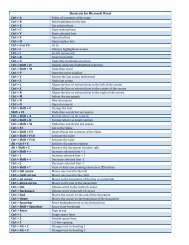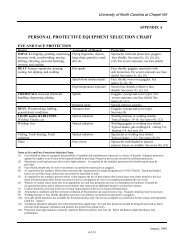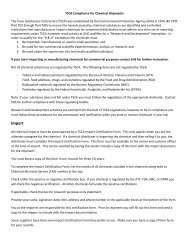Use of DMBA in Animals
Use of DMBA in Animals
Use of DMBA in Animals
Create successful ePaper yourself
Turn your PDF publications into a flip-book with our unique Google optimized e-Paper software.
SOP #: 002<br />
VERSION NO.: 1.0<br />
PREPARED BY: Cather<strong>in</strong>e Brennan (EHS)<br />
SUPERCEDES: n/a<br />
EFFECTIVE DATE: August 2010<br />
LAST REVISED: August 13, 2010<br />
Standard Operat<strong>in</strong>g Procedure<br />
For<br />
<strong>Use</strong> <strong>of</strong> <strong>DMBA</strong> <strong>in</strong> <strong>Animals</strong><br />
PURPOSE:<br />
This document establishes procedures for the safe handl<strong>in</strong>g and use <strong>of</strong> 7,12-<br />
dimethylbenz(a)anthracene, commonly known as <strong>DMBA</strong> (CAS# 57-97-6) <strong>in</strong> university Division<br />
<strong>of</strong> Laboratory Animal Medic<strong>in</strong>e (DLAM) facilities. <strong>DMBA</strong> is a highly potent carc<strong>in</strong>ogen that<br />
causes cancer and heritable genetic damage and is used to <strong>in</strong>duce cancer <strong>in</strong> animal models.<br />
Contact with eyes, sk<strong>in</strong> and cloth<strong>in</strong>g should be avoided and <strong>in</strong>halation <strong>of</strong> dust must be prevented.<br />
Based on the risk associated with the use <strong>of</strong> <strong>DMBA</strong> the safety procedures outl<strong>in</strong>ed below are<br />
required by all research staff and DLAM employees when work<strong>in</strong>g with <strong>DMBA</strong> <strong>in</strong> DLAM<br />
facilities.<br />
REQUIREMENTS:<br />
Animal Hous<strong>in</strong>g:<br />
All animal work associated with this chemical, will be conducted <strong>in</strong> the ABSL2 isolation<br />
cubicles.<br />
A “Chemical Hazard” sign should be posted on the entry door to <strong>in</strong>dicate <strong>DMBA</strong> use.<br />
The IACUC Chemical Hazard form should be posted on cubicle or entry door to <strong>in</strong>dicate<br />
<strong>DMBA</strong> use.<br />
Individual cages should be marked with a yellow chemical hazard card.<br />
Cages where <strong>DMBA</strong> is adm<strong>in</strong>istered to the animals should not be changed for 48 hours<br />
after last dose. If cages are <strong>in</strong> need to be changed research personnel will change the<br />
animal bedd<strong>in</strong>g.<br />
Adm<strong>in</strong>istrative Controls:<br />
The IACUC “<strong>Use</strong> <strong>of</strong> Chemical Hazards <strong>in</strong> <strong>Animals</strong>” form should be submitted and<br />
approved by EHS prior to work<strong>in</strong>g with <strong>DMBA</strong> <strong>in</strong> animals.<br />
Anyone who handles <strong>DMBA</strong> or works with animals that have been treated with <strong>DMBA</strong><br />
is required to review this SOP and the attached Material Safety Data Sheet (MSDS) prior<br />
to work.
Eng<strong>in</strong>eer<strong>in</strong>g Controls:<br />
Procedures that <strong>in</strong>volve handl<strong>in</strong>g <strong>DMBA</strong> must be conducted under exhaust ventilation <strong>in</strong><br />
a chemical fume hood or ducted Biological Safety Cab<strong>in</strong>et (BSC).<br />
Cage chang<strong>in</strong>g occurs with<strong>in</strong> a Biological Safety Cab<strong>in</strong>et (BSC).<br />
Personal Protective Equipment (PPE):<br />
Standard entry, gown<strong>in</strong>g, and personal hygiene procedures <strong>of</strong> ABSL2 will be followed.<br />
Wear double nitrile gloves when prepar<strong>in</strong>g or dispens<strong>in</strong>g <strong>DMBA</strong> solutions<br />
Safety glasses will be worn when handl<strong>in</strong>g <strong>DMBA</strong>, <strong>in</strong> the animal hold<strong>in</strong>g room and when<br />
cage chang<strong>in</strong>g as an additional precaution.<br />
Waste Disposal:<br />
All animal carcasses are to be <strong>in</strong>c<strong>in</strong>erated.<br />
Cages are to be autoclaved as per standard ABSL2 procedures.<br />
Animal bedd<strong>in</strong>g is to be <strong>in</strong>c<strong>in</strong>erated dur<strong>in</strong>g dos<strong>in</strong>g and for 48 hours after last dose.<br />
Unused solutions <strong>of</strong> <strong>DMBA</strong> and contam<strong>in</strong>ated solid waste will be disposed <strong>of</strong> as<br />
hazardous material (https://s4.its.unc.edu/HazMat_Pickup/)<br />
Accidents or Injuries:<br />
Animal bites do not pose any <strong>in</strong>creased risk. As per standard policy, report to supervisor.<br />
If <strong>DMBA</strong> solution is splashed on an <strong>in</strong>dividual or <strong>in</strong> eyes flush for 15 m<strong>in</strong>utes with<br />
copious quantities <strong>of</strong> water and contact the University Employee Occupational Health<br />
Cl<strong>in</strong>ic (966-9119).<br />
Spill procedures:<br />
o Do not attempt to clean-up if you feel unsure <strong>of</strong> your ability to do so or if you<br />
perceive the risk to be greater than normal laboratory operations.<br />
o If a small spill occurs absorb with absorbent pads. Double bag contam<strong>in</strong>ated solid<br />
waste and submit for hazardous material disposal<br />
(https://s4.its.unc.edu/HazMat_Pickup/).<br />
o If a large spill occurs notify others <strong>in</strong> the area and evacuate room immediately.<br />
Contact EHS (962-5507) dur<strong>in</strong>g work<strong>in</strong>g hours and 911 if after hours.<br />
2
SIGMA-ALDRICH<br />
sigma-aldrich.com<br />
Material Safety Data Sheet<br />
Version 4.0<br />
Revision Date 03/13/2010<br />
Pr<strong>in</strong>t Date 08/06/2010<br />
1. PRODUCT AND COMPANY IDENTIFICATION<br />
Product name : 7,12-Dimethylbenz[a]anthracene<br />
Product Number : D3254<br />
Brand : Sigma<br />
Company : Sigma-Aldrich<br />
3050 Spruce Street<br />
SAINT LOUIS MO 63103<br />
USA<br />
Telephone : +18003255832<br />
Fax : +18003255052<br />
Emergency Phone # : (314) 776-6555<br />
2. HAZARDS IDENTIFICATION<br />
Emergency Overview<br />
OSHA Hazards<br />
Toxic by <strong>in</strong>gestion, Carc<strong>in</strong>ogen, Teratogen, Mutagen<br />
GHS Label elements, <strong>in</strong>clud<strong>in</strong>g precautionary statements<br />
Pictogram<br />
Signal word<br />
Hazard statement(s)<br />
H302<br />
H316<br />
H350<br />
Danger<br />
Harmful if swallowed.<br />
Causes mild sk<strong>in</strong> irritation.<br />
May cause cancer.<br />
Precautionary statement(s)<br />
P201<br />
Obta<strong>in</strong> special <strong>in</strong>structions before use.<br />
P308 + P313<br />
IF exposed or concerned: Get medical advice/attention.<br />
HMIS Classification<br />
Health hazard: 2<br />
Chronic Health Hazard: *<br />
Flammability: 0<br />
Physical hazards: 0<br />
NFPA Rat<strong>in</strong>g<br />
Health hazard: 2<br />
Fire: 0<br />
Reactivity Hazard: 0<br />
Potential Health Effects<br />
Inhalation<br />
Sk<strong>in</strong><br />
Eyes<br />
Ingestion<br />
3. COMPOSITION/INFORMATION ON INGREDIENTS<br />
May be harmful if <strong>in</strong>haled. May cause respiratory tract irritation.<br />
May be harmful if absorbed through sk<strong>in</strong>. May cause sk<strong>in</strong> irritation.<br />
May cause eye irritation.<br />
Toxic if swallowed.<br />
Synonyms : 1,4-Dimethyl-2,3-benzophenanthrene<br />
Sigma - D3254 Page 3 <strong>of</strong> 8
Formula : C 20 H 16<br />
Molecular Weight : 256.34 g/mol<br />
<strong>DMBA</strong><br />
9,10-Dimethyl-1,2-benzanthracene<br />
CAS-No. EC-No. Index-No. Concentration<br />
7,12-Dimethylbenz[a]anthracene<br />
57-97-6 200-359-5 - -<br />
4. FIRST AID MEASURES<br />
General advice<br />
Consult a physician. Show this safety data sheet to the doctor <strong>in</strong> attendance.Move out <strong>of</strong> dangerous area.<br />
If <strong>in</strong>haled<br />
If breathed <strong>in</strong>, move person <strong>in</strong>to fresh air. If not breath<strong>in</strong>g give artificial respiration Consult a physician.<br />
In case <strong>of</strong> sk<strong>in</strong> contact<br />
Wash <strong>of</strong>f with soap and plenty <strong>of</strong> water. Consult a physician.<br />
In case <strong>of</strong> eye contact<br />
R<strong>in</strong>se thoroughly with plenty <strong>of</strong> water for at least 15 m<strong>in</strong>utes and consult a physician.<br />
If swallowed<br />
Never give anyth<strong>in</strong>g by mouth to an unconscious person. R<strong>in</strong>se mouth with water. Consult a physician.<br />
5. FIRE-FIGHTING MEASURES<br />
Suitable ext<strong>in</strong>guish<strong>in</strong>g media<br />
<strong>Use</strong> water spray, alcohol-resistant foam, dry chemical or carbon dioxide.<br />
Special protective equipment for fire-fighters<br />
Wear self conta<strong>in</strong>ed breath<strong>in</strong>g apparatus for fire fight<strong>in</strong>g if necessary.<br />
6. ACCIDENTAL RELEASE MEASURES<br />
Personal precautions<br />
<strong>Use</strong> personal protective equipment. Avoid dust formation. Avoid breath<strong>in</strong>g dust. Ensure adequate ventilation. Evacuate<br />
personnel to safe areas.<br />
Environmental precautions<br />
Prevent further leakage or spillage if safe to do so. Do not let product enter dra<strong>in</strong>s.<br />
Methods and materials for conta<strong>in</strong>ment and clean<strong>in</strong>g up<br />
Pick up and arrange disposal without creat<strong>in</strong>g dust. Keep <strong>in</strong> suitable, closed conta<strong>in</strong>ers for disposal.<br />
7. HANDLING AND STORAGE<br />
Precautions for safe handl<strong>in</strong>g<br />
Avoid formation <strong>of</strong> dust and aerosols.<br />
Provide appropriate exhaust ventilation at places where dust is formed. Normal measures for preventive fire protection.<br />
Conditions for safe storage<br />
Keep conta<strong>in</strong>er tightly closed <strong>in</strong> a dry and well-ventilated place.<br />
Keep <strong>in</strong> a dry place.<br />
Sigma - D3254 Page 4 <strong>of</strong> 8
8. EXPOSURE CONTROLS/PERSONAL PROTECTION<br />
Conta<strong>in</strong>s no substances with occupational exposure limit values.<br />
Personal protective equipment<br />
Respiratory protection<br />
Where risk assessment shows air-purify<strong>in</strong>g respirators are appropriate use a full-face particle respirator type N100<br />
(US) or type P3 (EN 143) respirator cartridges as a backup to eng<strong>in</strong>eer<strong>in</strong>g controls. If the respirator is the sole<br />
means <strong>of</strong> protection, use a full-face supplied air respirator. <strong>Use</strong> respirators and components tested and approved<br />
under appropriate government standards such as NIOSH (US) or CEN (EU).<br />
Hand protection<br />
Handle with gloves.<br />
Eye protection<br />
Face shield and safety glasses<br />
Sk<strong>in</strong> and body protection<br />
Choose body protection accord<strong>in</strong>g to the amount and concentration <strong>of</strong> the dangerous substance at the work place.<br />
Hygiene measures<br />
Avoid contact with sk<strong>in</strong>, eyes and cloth<strong>in</strong>g. Wash hands before breaks and immediately after handl<strong>in</strong>g the product.<br />
9. PHYSICAL AND CHEMICAL PROPERTIES<br />
Appearance<br />
Form<br />
Colour<br />
Safety data<br />
pH<br />
Melt<strong>in</strong>g po<strong>in</strong>t<br />
Boil<strong>in</strong>g po<strong>in</strong>t<br />
Flash po<strong>in</strong>t<br />
Ignition temperature<br />
Lower explosion limit<br />
Upper explosion limit<br />
Water solubility<br />
powder<br />
light yellow<br />
no data available<br />
122 - 123 °C (252 - 253 °F) - lit.<br />
no data available<br />
no data available<br />
no data available<br />
no data available<br />
no data available<br />
no data available<br />
10. STABILITY AND REACTIVITY<br />
Chemical stability<br />
Stable under recommended storage conditions.<br />
Conditions to avoid<br />
no data available<br />
Materials to avoid<br />
Strong oxidiz<strong>in</strong>g agents<br />
Hazardous decomposition products<br />
Hazardous decomposition products formed under fire conditions. - Carbon oxides<br />
11. TOXICOLOGICAL INFORMATION<br />
Acute toxicity<br />
LD50 Oral - rat - 327 mg/kg<br />
Sk<strong>in</strong> corrosion/irritation<br />
Sk<strong>in</strong> - mouse - Mild sk<strong>in</strong> irritation<br />
Sigma - D3254 Page 5 <strong>of</strong> 8
Serious eye damage/eye irritation<br />
no data available<br />
Respiratory or sk<strong>in</strong> sensitization<br />
no data available<br />
Germ cell mutagenicity<br />
Laboratory experiments have shown mutagenic effects.<br />
Carc<strong>in</strong>ogenicity<br />
This product is or conta<strong>in</strong>s a component that has been reported to be probably carc<strong>in</strong>ogenic based on its IARC, OSHA,<br />
ACGIH, NTP, or EPA classification.<br />
Possible human carc<strong>in</strong>ogen<br />
IARC: No component <strong>of</strong> this product present at levels greater than or equal to 0.1% is identified as probable,<br />
possible or confirmed human carc<strong>in</strong>ogen by IARC.<br />
ACGIH: No component <strong>of</strong> this product present at levels greater than or equal to 0.1% is identified as a<br />
carc<strong>in</strong>ogen or potential carc<strong>in</strong>ogen by ACGIH.<br />
NTP: No component <strong>of</strong> this product present at levels greater than or equal to 0.1% is identified as a known or<br />
anticipated carc<strong>in</strong>ogen by NTP.<br />
OSHA: No component <strong>of</strong> this product present at levels greater than or equal to 0.1% is identified as a<br />
carc<strong>in</strong>ogen or potential carc<strong>in</strong>ogen by OSHA.<br />
Reproductive toxicity<br />
Laboratory experiments have shown teratogenic effects.<br />
Specific target organ toxicity - s<strong>in</strong>gle exposure (GHS)<br />
no data available<br />
Specific target organ toxicity - repeated exposure (GHS)<br />
no data available<br />
Aspiration hazard<br />
no data available<br />
Potential health effects<br />
Inhalation<br />
May be harmful if <strong>in</strong>haled. May cause respiratory tract irritation.<br />
Ingestion<br />
Toxic if swallowed.<br />
Sk<strong>in</strong><br />
May be harmful if absorbed through sk<strong>in</strong>. May cause sk<strong>in</strong> irritation.<br />
Eyes<br />
May cause eye irritation.<br />
Additional Information<br />
RTECS: CW3850000<br />
12. ECOLOGICAL INFORMATION<br />
Toxicity<br />
no data available<br />
Persistence and degradability<br />
no data available<br />
Bioaccumulative potential<br />
no data available<br />
Mobility <strong>in</strong> soil<br />
no data available<br />
PBT and vPvB assessment<br />
no data available<br />
Other adverse effects<br />
no data available<br />
Sigma - D3254 Page 6 <strong>of</strong> 8
13. DISPOSAL CONSIDERATIONS<br />
Product<br />
Observe all federal, state, and local environmental regulations. Contact a licensed pr<strong>of</strong>essional waste disposal service<br />
to dispose <strong>of</strong> this material. Dissolve or mix the material with a combustible solvent and burn <strong>in</strong> a chemical <strong>in</strong>c<strong>in</strong>erator<br />
equipped with an afterburner and scrubber.<br />
Contam<strong>in</strong>ated packag<strong>in</strong>g<br />
Dispose <strong>of</strong> as unused product.<br />
14. TRANSPORT INFORMATION<br />
DOT (US)<br />
UN-Number: 3077 Class: 9<br />
Pack<strong>in</strong>g group: III<br />
Proper shipp<strong>in</strong>g name: Environmentally hazardous substances, solid, n.o.s.<br />
Reportable Quantity (RQ): 1 lbs<br />
Mar<strong>in</strong>e pollutant: No<br />
Poison Inhalation Hazard: No<br />
IMDG<br />
Not dangerous goods<br />
IATA<br />
Not dangerous goods<br />
15. REGULATORY INFORMATION<br />
OSHA Hazards<br />
Toxic by <strong>in</strong>gestion, Carc<strong>in</strong>ogen, Teratogen, Mutagen<br />
DSL Status<br />
All components <strong>of</strong> this product are on the Canadian DSL list.<br />
SARA 302 Components<br />
SARA 302: No chemicals <strong>in</strong> this material are subject to the report<strong>in</strong>g requirements <strong>of</strong> SARA Title III, Section 302.<br />
SARA 313 Components<br />
SARA 313: This material does not conta<strong>in</strong> any chemical components with known CAS numbers that exceed the threshold<br />
(De M<strong>in</strong>imis) report<strong>in</strong>g levels established by SARA Title III, Section 313.<br />
SARA 311/312 Hazards<br />
Acute Health Hazard, Chronic Health Hazard<br />
Massachusetts Right To Know Components<br />
7,12-Dimethylbenz[a]anthracene<br />
Pennsylvania Right To Know Components<br />
7,12-Dimethylbenz[a]anthracene<br />
New Jersey Right To Know Components<br />
7,12-Dimethylbenz[a]anthracene<br />
California Prop. 65 Components<br />
WARNING! This product conta<strong>in</strong>s a chemical known to the State <strong>of</strong><br />
California to cause cancer.<br />
7,12-Dimethylbenz[a]anthracene<br />
CAS-No.<br />
57-97-6<br />
CAS-No.<br />
57-97-6<br />
CAS-No.<br />
57-97-6<br />
CAS-No.<br />
57-97-6<br />
Revision Date<br />
1993-04-24<br />
Revision Date<br />
1993-04-24<br />
Revision Date<br />
1993-04-24<br />
Revision Date<br />
2007-09-28<br />
16. OTHER INFORMATION<br />
Further <strong>in</strong>formation<br />
Copyright 2010 Sigma-Aldrich Co. License granted to make unlimited paper copies for <strong>in</strong>ternal use only.<br />
Sigma - D3254 Page 7 <strong>of</strong> 8
The above <strong>in</strong>formation is believed to be correct but does not purport to be all <strong>in</strong>clusive and shall be used only as a<br />
guide. The <strong>in</strong>formation <strong>in</strong> this document is based on the present state <strong>of</strong> our knowledge and is applicable to the<br />
product with regard to appropriate safety precautions. It does not represent any guarantee <strong>of</strong> the properties <strong>of</strong> the<br />
product. Sigma-Aldrich Co., shall not be held liable for any damage result<strong>in</strong>g from handl<strong>in</strong>g or from contact with the<br />
above product. See reverse side <strong>of</strong> <strong>in</strong>voice or pack<strong>in</strong>g slip for additional terms and conditions <strong>of</strong> sale.<br />
Sigma - D3254 Page 8 <strong>of</strong> 8



